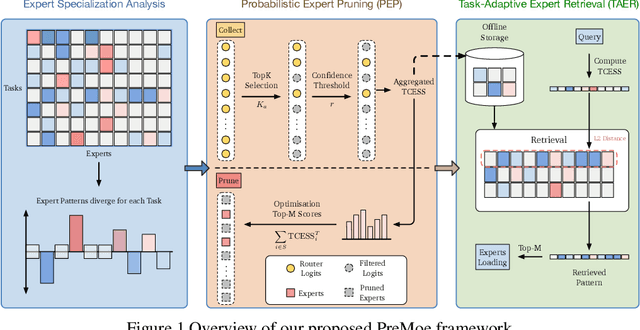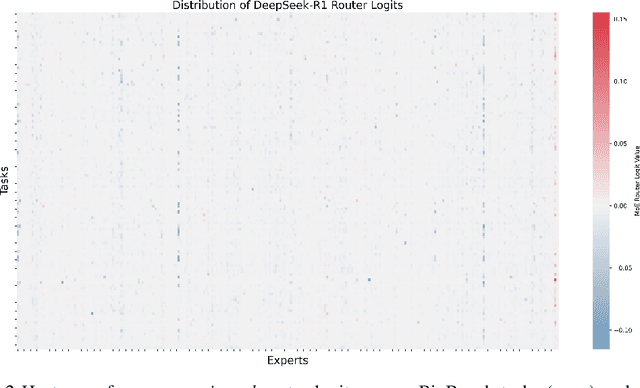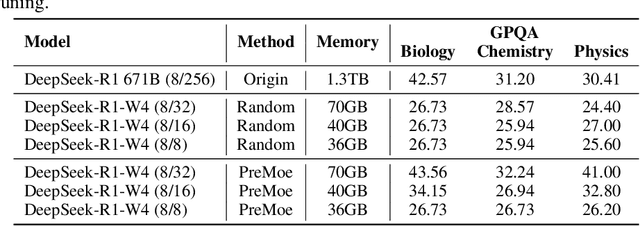Bei Yu
From Noisy Traces to Stable Gradients: Bias-Variance Optimized Preference Optimization for Aligning Large Reasoning Models
Oct 06, 2025Abstract:Large reasoning models (LRMs) generate intermediate reasoning traces before producing final answers, yielding strong gains on multi-step and mathematical tasks. Yet aligning LRMs with human preferences, a crucial prerequisite for model deployment, remains underexplored. The statistically correct objective for preference alignment requires marginalizing over reasoning traces, but this computation is intractable in practice. A common workaround optimizes a single sampled trajectory, which introduces substantial gradient variance from stochastic trace sampling. To address this challenge, we frame preference optimization for LRMs through the lens of the bias--variance trade-off and propose Bias--Variance Optimized Preference Optimization (BVPO), a simple, drop-in method that mixes two gradient estimators: a high-variance trace-based estimator and a low-variance empty-trace estimator obtained by disabling reasoning trace generation. Our theory shows that BVPO strictly reduces trace-induced variance for any nontrivial mixture, provides a closed-form choice of the mixing weight that minimizes mean-squared error relative to the true marginal gradient, and under standard smoothness and step-size conditions, tightens classical convergence bounds for stochastic gradient descent. Empirically, BVPO improves alignment over the best baseline by up to 7.8 points on AlpacaEval~2 and 6.8 points on Arena-Hard. Despite being trained only on general conversational data, BVPO also boosts reasoning performance for base models by up to 4.0 points on the average of six math reasoning benchmarks. These results identify variance from trace sampling as a key bottleneck and demonstrate that directly optimizing the bias--variance trade-off yields more stable training and stronger overall performance.
Grove MoE: Towards Efficient and Superior MoE LLMs with Adjugate Experts
Aug 11, 2025Abstract:The Mixture of Experts (MoE) architecture is a cornerstone of modern state-of-the-art (SOTA) large language models (LLMs). MoE models facilitate scalability by enabling sparse parameter activation. However, traditional MoE architecture uses homogeneous experts of a uniform size, activating a fixed number of parameters irrespective of input complexity and thus limiting computational efficiency. To overcome this limitation, we introduce Grove MoE, a novel architecture incorporating experts of varying sizes, inspired by the heterogeneous big.LITTLE CPU architecture. This architecture features novel adjugate experts with a dynamic activation mechanism, enabling model capacity expansion while maintaining manageable computational overhead. Building on this architecture, we present GroveMoE-Base and GroveMoE-Inst, 33B-parameter LLMs developed by applying an upcycling strategy to the Qwen3-30B-A3B-Base model during mid-training and post-training. GroveMoE models dynamically activate 3.14-3.28B parameters based on token complexity and achieve performance comparable to SOTA open-source models of similar or even larger size.
DreamVE: Unified Instruction-based Image and Video Editing
Aug 08, 2025Abstract:Instruction-based editing holds vast potential due to its simple and efficient interactive editing format. However, instruction-based editing, particularly for video, has been constrained by limited training data, hindering its practical application. To this end, we introduce DreamVE, a unified model for instruction-based image and video editing. Specifically, We propose a two-stage training strategy: first image editing, then video editing. This offers two main benefits: (1) Image data scales more easily, and models are more efficient to train, providing useful priors for faster and better video editing training. (2) Unifying image and video generation is natural and aligns with current trends. Moreover, we present comprehensive training data synthesis pipelines, including collage-based and generative model-based data synthesis. The collage-based data synthesis combines foreground objects and backgrounds to generate diverse editing data, such as object manipulation, background changes, and text modifications. It can easily generate billions of accurate, consistent, realistic, and diverse editing pairs. We pretrain DreamVE on extensive collage-based data to achieve strong performance in key editing types and enhance generalization and transfer capabilities. However, collage-based data lacks some attribute editing cases, leading to a relative drop in performance. In contrast, the generative model-based pipeline, despite being hard to scale up, offers flexibility in handling attribute editing cases. Therefore, we use generative model-based data to further fine-tune DreamVE. Besides, we design an efficient and powerful editing framework for DreamVE. We build on the SOTA T2V model and use a token concatenation with early drop approach to inject source image guidance, ensuring strong consistency and editability. The codes and models will be released.
VisionThink: Smart and Efficient Vision Language Model via Reinforcement Learning
Jul 17, 2025Abstract:Recent advancements in vision-language models (VLMs) have improved performance by increasing the number of visual tokens, which are often significantly longer than text tokens. However, we observe that most real-world scenarios do not require such an extensive number of visual tokens. While the performance drops significantly in a small subset of OCR-related tasks, models still perform accurately in most other general VQA tasks with only 1/4 resolution. Therefore, we propose to dynamically process distinct samples with different resolutions, and present a new paradigm for visual token compression, namely, VisionThink. It starts with a downsampled image and smartly decides whether it is sufficient for problem solving. Otherwise, the model could output a special token to request the higher-resolution image. Compared to existing Efficient VLM methods that compress tokens using fixed pruning ratios or thresholds, VisionThink autonomously decides whether to compress tokens case by case. As a result, it demonstrates strong fine-grained visual understanding capability on OCR-related tasks, and meanwhile saves substantial visual tokens on simpler tasks. We adopt reinforcement learning and propose the LLM-as-Judge strategy to successfully apply RL to general VQA tasks. Moreover, we carefully design a reward function and penalty mechanism to achieve a stable and reasonable image resize call ratio. Extensive experiments demonstrate the superiority, efficiency, and effectiveness of our method. Our code is available at https://github.com/dvlab-research/VisionThink.
Deep-Learning-Based Pre-Layout Parasitic Capacitance Prediction on SRAM Designs
Jul 09, 2025Abstract:To achieve higher system energy efficiency, SRAM in SoCs is often customized. The parasitic effects cause notable discrepancies between pre-layout and post-layout circuit simulations, leading to difficulty in converging design parameters and excessive design iterations. Is it possible to well predict the parasitics based on the pre-layout circuit, so as to perform parasitic-aware pre-layout simulation? In this work, we propose a deep-learning-based 2-stage model to accurately predict these parasitics in pre-layout stages. The model combines a Graph Neural Network (GNN) classifier and Multi-Layer Perceptron (MLP) regressors, effectively managing class imbalance of the net parasitics in SRAM circuits. We also employ Focal Loss to mitigate the impact of abundant internal net samples and integrate subcircuit information into the graph to abstract the hierarchical structure of schematics. Experiments on 4 real SRAM designs show that our approach not only surpasses the state-of-the-art model in parasitic prediction by a maximum of 19X reduction of error but also significantly boosts the simulation process by up to 598X speedup.
TGDPO: Harnessing Token-Level Reward Guidance for Enhancing Direct Preference Optimization
Jun 17, 2025Abstract:Recent advancements in reinforcement learning from human feedback have shown that utilizing fine-grained token-level reward models can substantially enhance the performance of Proximal Policy Optimization (PPO) in aligning large language models. However, it is challenging to leverage such token-level reward as guidance for Direct Preference Optimization (DPO), since DPO is formulated as a sequence-level bandit problem. To address this challenge, this work decomposes the sequence-level PPO into a sequence of token-level proximal policy optimization problems and then frames the problem of token-level PPO with token-level reward guidance, from which closed-form optimal token-level policy and the corresponding token-level reward can be derived. Using the obtained reward and Bradley-Terry model, this work establishes a framework of computable loss functions with token-level reward guidance for DPO, and proposes a practical reward guidance based on the induced DPO reward. This formulation enables different tokens to exhibit varying degrees of deviation from reference policy based on their respective rewards. Experiment results demonstrate that our method achieves substantial performance improvements over DPO, with win rate gains of up to 7.5 points on MT-Bench, 6.2 points on AlpacaEval 2, and 4.3 points on Arena-Hard. Code is available at https://github.com/dvlab-research/TGDPO.
SwingArena: Competitive Programming Arena for Long-context GitHub Issue Solving
May 29, 2025Abstract:We present SwingArena, a competitive evaluation framework for Large Language Models (LLMs) that closely mirrors real-world software development workflows. Unlike traditional static benchmarks, SwingArena models the collaborative process of software iteration by pairing LLMs as submitters, who generate patches, and reviewers, who create test cases and verify the patches through continuous integration (CI) pipelines. To support these interactive evaluations, we introduce a retrieval-augmented code generation (RACG) module that efficiently handles long-context challenges by providing syntactically and semantically relevant code snippets from large codebases, supporting multiple programming languages (C++, Python, Rust, and Go). This enables the framework to scale across diverse tasks and contexts while respecting token limitations. Our experiments, using over 400 high-quality real-world GitHub issues selected from a pool of 2,300 issues, show that models like GPT-4o excel at aggressive patch generation, whereas DeepSeek and Gemini prioritize correctness in CI validation. SwingArena presents a scalable and extensible methodology for evaluating LLMs in realistic, CI-driven software development settings. More details are available on our project page: swing-bench.github.io
RTime-QA: A Benchmark for Atomic Temporal Event Understanding in Large Multi-modal Models
May 25, 2025Abstract:Understanding accurate atomic temporal event is essential for video comprehension. However, current video-language benchmarks often fall short to evaluate Large Multi-modal Models' (LMMs) temporal event understanding capabilities, as they can be effectively addressed using image-language models. In this paper, we introduce RTime-QA, a novel benchmark specifically designed to assess the atomic temporal event understanding ability of LMMs. RTime-QA comprises 822 high-quality, carefully-curated video-text questions, each meticulously annotated by human experts. Each question features a video depicting an atomic temporal event, paired with both correct answers and temporal negative descriptions, specifically designed to evaluate temporal understanding. To advance LMMs' temporal event understanding ability, we further introduce RTime-IT, a 14k instruction-tuning dataset that employs a similar annotation process as RTime-QA. Extensive experimental analysis demonstrates that RTime-QA presents a significant challenge for LMMs: the state-of-the-art model Qwen2-VL achieves only 34.6 on strict-ACC metric, substantially lagging behind human performance. Furthermore, our experiments reveal that RTime-IT effectively enhance LMMs' capacity in temporal understanding. By fine-tuning on RTime-IT, our Qwen2-VL achieves 65.9 on RTime-QA.
PreMoe: Lightening MoEs on Constrained Memory by Expert Pruning and Retrieval
May 23, 2025



Abstract:Mixture-of-experts (MoE) architectures enable scaling large language models (LLMs) to vast parameter counts without a proportional rise in computational costs. However, the significant memory demands of large MoE models hinder their deployment across various computational environments, from cloud servers to consumer devices. This study first demonstrates pronounced task-specific specialization in expert activation patterns within MoE layers. Building on this, we introduce PreMoe, a novel framework that enables efficient deployment of massive MoE models in memory-constrained environments. PreMoe features two main components: probabilistic expert pruning (PEP) and task-adaptive expert retrieval (TAER). PEP employs a new metric, the task-conditioned expected selection score (TCESS), derived from router logits to quantify expert importance for specific tasks, thereby identifying a minimal set of critical experts. TAER leverages these task-specific expert importance profiles for efficient inference. It pre-computes and stores compact expert patterns for diverse tasks. When a user query is received, TAER rapidly identifies the most relevant stored task pattern and reconstructs the model by loading only the small subset of experts crucial for that task. This approach dramatically reduces the memory footprint across all deployment scenarios. DeepSeek-R1 671B maintains 97.2\% accuracy on MATH500 when pruned to 8/128 configuration (50\% expert reduction), and still achieves 72.0\% with aggressive 8/32 pruning (87.5\% expert reduction). Pangu-Ultra-MoE 718B achieves 97.15\% on MATH500 and 81.3\% on AIME24 with 8/128 pruning, while even more aggressive pruning to 4/64 (390GB memory) preserves 96.95\% accuracy on MATH500. We make our code publicly available at https://github.com/JarvisPei/PreMoe.
On-Policy Optimization with Group Equivalent Preference for Multi-Programming Language Understanding
May 19, 2025Abstract:Large language models (LLMs) achieve remarkable performance in code generation tasks. However, a significant performance disparity persists between popular programming languages (e.g., Python, C++) and others. To address this capability gap, we leverage the code translation task to train LLMs, thereby facilitating the transfer of coding proficiency across diverse programming languages. Moreover, we introduce OORL for training, a novel reinforcement learning (RL) framework that integrates on-policy and off-policy strategies. Within OORL, on-policy RL is applied during code translation, guided by a rule-based reward signal derived from unit tests. Complementing this coarse-grained rule-based reward, we propose Group Equivalent Preference Optimization (GEPO), a novel preference optimization method. Specifically, GEPO trains the LLM using intermediate representations (IRs) groups. LLMs can be guided to discern IRs equivalent to the source code from inequivalent ones, while also utilizing signals about the mutual equivalence between IRs within the group. This process allows LLMs to capture nuanced aspects of code functionality. By employing OORL for training with code translation tasks, LLMs improve their recognition of code functionality and their understanding of the relationships between code implemented in different languages. Extensive experiments demonstrate that our OORL for LLMs training with code translation tasks achieves significant performance improvements on code benchmarks across multiple programming languages.
 Add to Chrome
Add to Chrome Add to Firefox
Add to Firefox Add to Edge
Add to Edge